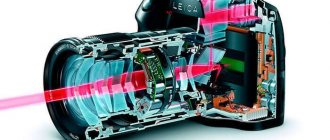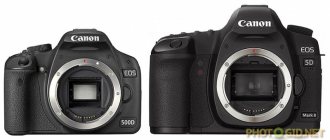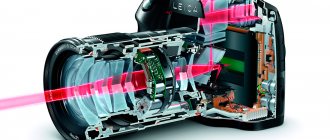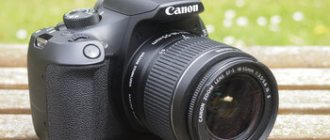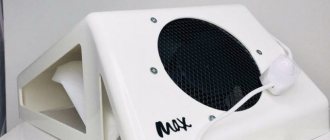What is a SLR camera?
Advantages:
- High image quality
- Long battery life
- Durability
- Huge selection of lenses and accessories
- Lots of customizable settings
- Excellent value for money and quality
Flaws
- Heavy
- Bulky size
- Loud descent
A DSLR is a digital SLR camera with a single lens. You're using a digital sensor, not old film. SLR is short for Single Lens Reflex, which means one lens and a reflex camera. The light captured by the viewfinder fades after receiving many reflections from the DSLR camera elements. The mirror is located in the camera behind the lens at a 45-degree angle, and light passes through the lens into the mirror (or pentagon-shaped prism, depending on the model).
Light from the mirror shines into the viewfinder, allowing you to see what kind of image you took. When you press the shutter button, the mirror flips. Light then passes through the shutter to the sensor a number of times specified by the shutter speed.
Dimensions
Since mirrorless cameras do not have a mirror unit, they are more compact and lightweight. Here everyone decides for themselves whether to shoot with a large camera and look like a professional, or choose a smaller camera.
On the left is a mirrorless camera. On the right is a DSLR camera.
But don't forget that SLR cameras are becoming more compact and lighter. And mirrorless cameras are acquiring new capabilities and inevitably getting larger. But for now there is still a difference between them.
What is a mirrorless camera?
Advantages
- High quality photos
- Compact size and weight
- Fast shooting speed
- Quiet descent
- Live image preview
- Video-oriented
Flaws
- Short battery life
- Limited selection of lenses and accessories
- Limited number of customizable settings
- More expensive than DSLRs with similar characteristics
From the name it is quite clear that a mirrorless camera is a camera that does not require a mirror, which is an important element of DSLR cameras.
Light is reflected to the optical viewfinder by a mirror in a DSLR camera. A mirrorless camera does not have this mechanism. In addition, the image sensor is constantly exposed to light. If you compare mirror mechanisms with mirrorless cameras, the second one is simpler. To be clearer, light enters the image sensor through the lens. Instead of an optical viewfinder, an electronic viewfinder is used, which doubles as an image sensor. Since these cameras appeared after DSLR cameras, they were simply called mirrorless to draw attention to their main difference.
Lenses
Lenses for DSLRs and mirrorless cameras require different lenses. Modern SLR cameras have a longer history, so many more lenses have been invented for them.
Lenses for mirrorless cameras benefit from compactness, but there is less choice and they are more expensive.
But there is a solution to this problem. All manufacturers have adapters that allow you to use lenses from SLR cameras.
Difference between mirrorless and DSLR cameras
Mirrorless cameras first appeared almost ten years ago. However, recently they have begun to gain popularity in the market of novice photographers. Many manufacturers such as Canon and Nikon, which specialize in producing DSLR cameras, have switched to mirrorless cameras. They have differences that you need to know before purchasing a camera.
Size and weight of cameras
Where and what are you going to shoot? In most cases, you will always take your camera with you, so it should be mobile and easy to carry. Probably the most important difference between mirrorless and DSLR cameras is their size. As you might have guessed, a DSLR camera with its design is quite large and not as lightweight as a mirrorless camera. Thanks to the body, pentaprism and additional autofocus mirror, as well as other parts of the autofocus system, a DSLR camera is significantly heavier. The most important advantage of a mirrorless camera is its portability. Therefore, customers will prefer such a camera with less weight. This is especially important for those who always take their camera with them everywhere. With a heavy DSLR camera, you may feel discomfort after a full day of shooting.
Cost of DSLR and mirrorless cameras
When it comes to value for money, DSLRs are better. If we compare the prices of DSLR cameras with mirrorless cameras, they range from $500 to $5000. In any price range, you can find a suitable DSLR or mirrorless camera. However, you should take into account the fact that prices do not always correspond to camera specifications. When comparing mirrorless cameras to DSLRs, most professional camera bodies are basically similar.
It doesn't matter if it's a DSLR or a mirrorless camera, you'll get the same set of features, almost identical functionality and performance for almost the same price. The difference is noticeable when we talk about cheaper models. You can buy an entry-level to mid-level DSLR for around $500 and have a good range and feature set. Mirrorless cameras will not have good battery life or viewfinder. Additionally, you may need to compromise on resolution.
Image preview
DSLR cameras have an optical viewfinder. Through the camera's very small window you can see the image. It's hard to know what the final image will be like when you're just looking through the optical viewfinder. You must adjust the exposure.
Comparing DSLR with mirrorless cameras, the latter have another image preview. On the very small electronic viewfinder (EVF, which is used on most, but not every model) of a mirrorless camera display, we can see what the camera sensor sees. This allows you to see what you are going to photograph in advance. If there are problems with white balance, saturation or contrast, you will see everything on the screen. There are also mirrorless cameras equipped with an electronic viewfinder (EVF), which simulates an optical viewfinder.
Lenses for SLR and mirrorless cameras
DSLR cameras offer a huge selection of accessories and lenses, both in-house and third-party for a wider choice. They also feature a wide range of specific common lenses, such as versatile zoom lenses or classic 50mm lenses. This is because DSLRs are cameras with a long history. Companies have been creating lenses for them for a long time. Of course, you can choose from a wide range of lenses. Mirrorless cameras also require lenses, but these are more advanced and still in development. Although mirrorless brands have many achievements, they still continue to improve their products. But for now, one lens will not fit all models.
So before purchasing, make sure that you are getting one that is compatible with your camera. Can you use a DSLR lens on a mirrorless camera?
You can do this if the camera mount and lens are the same, or you can find a suitable lens mount adapter.
Read more about the best lenses: Which camera lens is better to choose: Tips, rating
Accessories
Another advantage of DSLR cameras is the ability to use a huge number of accessories and equipment with them. Most mirrors have what is called a "hot shoe". This is an electrified mount on the top of the camera. It is typically used for flashes, but other devices such as microphones or wireless triggers can also be connected to the camera. The ports can also be used to attach external monitors, wired flashes, microphones, trigger systems, or even GPS modules. This flexibility of using a DSLR camera allows you to tailor it to your own preferences, whether it's for a studio or outdoor photo shoot. So, comparing mirrorless cameras with DSLRs, we can say that the number of accessories and lenses for mirrorless cameras is noticeably smaller.
Shutter sound
When you press the shutter button on a DSLR camera, the mirror inside the camera lifts up to reveal the sensor. This well-known sound is familiar to us and someone may even like it. However, there are situations when shooting where complete silence is required.
For example, in some cases a loud shutter sound is not suitable, a mirrorless camera will help you minimize the noise since it does not have a flip-up mirror.
Battery life
When it comes to the battery life of DSLR and mirrorless cameras, the latter does not stand up to long shooting times. There are two reasons why mirrorless camera resources are so low. Firstly, the battery is small and does not have a long battery life due to the size of the camera itself. Secondly, the live view mode works 100%. A mirrorless camera takes several hundred images on a single battery charge, which is a big difference between an older DSLR and a mirrorless camera. DSLR cameras have larger batteries due to their larger size.
The gap between DSLR and mirrorless cameras is narrowing, but most DSLRs still have twice the battery life. It's important to remember that the number of shots you can take with a mirrorless camera is limited due to its weak battery. With a DSLR, you can take thousands of photos without needing to recharge.
Focus system
The main drawback of the first mirrorless cameras was their autofocus design, which was based on contrast detection. At the same time, SLR cameras were equipped with a so-called phase detection system. The main element here is a special sensor.
The light is redirected onto it using the camera's mirror. Speaking about DSLR cameras, it should be noted that with the development of technology, the difference in the quality of the autofocus system has noticeably decreased.
Modern manufacturers create cameras with combined autofocus, which contains elements of both contrast and phase detection. Thanks to this, mirrorless cameras can compete with their DSLR counterparts. Although it is necessary to take into account the features of each model separately. In general, I can say that both types of cameras have good autofocus. Due to the large number of AF points, you can manually or automatically adjust AF points on both types of cameras.
Photo quality
You can take amazing photos with both DSLR and mirrorless cameras. Manufacturers are now equipping their cameras with the best full-frame sensors. As a result, using cameras with similar settings and technical characteristics, you get the same image quality. To summarize, when comparing identical models, the difference between mirrorless and DSLR cameras in terms of image quality is almost negligible.
Video quality
Nowadays, all cameras have video recording function. However, when choosing a DSLR or mirrorless camera, you need to pay attention to the video quality you can get. While you have access to a huge selection of DSLR camera lenses, not all of them can record high-quality video. If you want to record in 4K or Ultra HD, you'll have to buy expensive, high-quality models. When it comes to mirrorless cameras, you can get great results even with inexpensive models.
Image stabilization
The ability to minimize the negative effects of hand movement and avoid blurring of photographs is important for all photographers. Therefore, when talking about mirrorless and DSLR cameras, it is worth paying attention to this function. Developers of both types of cameras use image stabilization systems. This means that when the camera detects movement with the sensor, it begins to move the sensor or part of the lens in the opposite direction of the push. It's worth noting that some mirrorless cameras offer greater stability due to the movement of the sensor and lens.
In the case of stabilization, there is no clear advantage for any type of camera. If stabilization is provided by the sensor, then you can work with all lenses. At the same time, lens stabilization is only possible when using built-in lenses, and they are quite expensive. Preventing the unwanted effects of slight jitter is possible with all modern models.
Shooting speed
When it comes to shooting speed, comparing a mirrorless camera to a DSLR camera, the former will be slightly better than its competitor. The reason for this is that with each shot, the mirror in a DSLR camera moves up, which reduces the speed.
Control setup
DSLR cameras are equipped with large navigation buttons and massive control wheels. While many photographers prefer automatic controls, you'll appreciate this feature if you want to manually adjust settings. Mirrorless cameras have fewer settings, making them the preferred option for beginners. You don't need to spend a lot of time studying detailed instructions.
You can also adjust various settings manually to suit your style and goals, or use the automatic mode. DSLR cameras give you more control over different modes and also allow you to adjust exposure, shutter speed, etc. On the other hand, such a wide variety of options can be confusing and difficult for new photographers.
Durability
If you don't intend to work in a studio, then you need to consider comparing DSLR and mirrorless cameras in terms of durability and protection. Manufacturers of digital SLR and mirrorless cameras use high-quality alloys for their bodies to provide maximum protection from various weather conditions such as rain, snow, dirt, dust, etc. It is worth noting that DSLR cameras are equipped with a shutter and a movable mirror that can operate only for a certain time. Typically, most professional blinds operate approximately 150,000 times. After that, you need to replace these elements. If you don't shoot too often, this number may be enough for a long period. Otherwise, repairs will cost you about 10-20 thousand rubles.
Mirrorless cameras also have their disadvantages. For example, Sony Alpha mirrorless cameras heat up during long periods of shooting. In addition, some models do not have a mirror that separates the sensor from the environment, which is also a problem. Dust accumulation can result in expensive sensor cleaning services. If you often photograph in dusty places and change lenses, you can purchase a dedicated cleaning kit to reduce the maintenance costs of your mirrorless camera. As you can see, both cameras are quite durable, although they do have minor flaws.
Ergonomics
When it comes to ergonomics, a DSLR camera has some advantages over a mirrorless camera. Deeper grips allow you to hold your DSLR camera comfortably and securely in your hands. Thanks to the special design, you can hold the camera calmly when shooting in extreme conditions, at heights or in wet weather. You will appreciate this advantage in cases where you need to conduct a long photo shoot. The comfortable grip makes the heavy weight much less noticeable. In turn, mirrorless cameras do not have cool ergonomics. The way you hold them is not very comfortable and sometimes strange.
Stealth
In cases where you don't want to attract a lot of attention and remain as inconspicuous as possible, DSLR cameras are inferior to their competitors. The large size of the camera does not allow it to be hidden from the attentive eyes of security guards at official events. If you don't have a permit, you won't be able to take photos, whether you're a tourist or a professional photographer. If you use a mirrorless camera, you are more likely to continue shooting without any difficulty.
Sensor dimensions
When we look at the pros and cons of mirrorless and DSLR cameras, one of the main features is the sensor size. It should be noted that many people mistakenly believe that the number of megapixels is the most important in a camera. Although the most important parameter is the physical dimensions of the sensor. They allow you to capture better images with DSLRs compared to photos taken with a smartphone. You're probably already familiar with the term "full frame". It refers to the 35mm image sensor, which is ideal for shallow depth of field in most cases. Modern camera manufacturers of both types have decent camera options with large full-frame sensors that can deliver the results you want. You need to pay more attention to price and other features.
Mirrorless cameras vs DSLRs or Why DSLR cameras are doomed
First, a little about the ins and outs of DSLRs. This unspoken nickname “stuck” to them due to the structural features - one of the main characters in the design of cameras of this kind is the moving mirror mechanism. It is used to ensure visibility of the field of the future frame in the optical viewfinder window
. Reflecting from the mirror, the light is reflected two more times through the faces of the pentaprism and only then enters directly into the viewfinder. When you press the shutter button, the mirror is removed from the path of the light stream so that it can easily penetrate the camera matrix. Moreover, the moment of shooting itself remains invisible in the viewfinder, since the raised mirror covers the matte focusing screen. In fact, the mirror mechanism is only an auxiliary element in the process of creating a photograph. Due to its bulky size, DSLR cameras are destined to be large and heavy. With mirrorless cameras getting on their feet, you can safely do without this mechanism.
| A clear difference between the operating principles of DSLRs and mirrorless cameras. |
Mirrorless cameras are good because the light flow is directed directly to the image sensor, bypassing all intermediate links in the chain. Accordingly, they have a simpler design, fewer fragile elements in it and, importantly, more attractive weight and size indicators. One of the main trump cards up the sleeves of mirrorless cameras:
Compact dimensions
With similar technical data, a DSLR of similar dimensions to a system camera with interchangeable lenses simply cannot be found. What can I say, the youngest of the mirrorless squad are practically indistinguishable in size from the average “digital point-and-shoot cameras”
, especially in combination with any of the “pancake” lenses. In addition, due to their short flange length, mirrorless cameras often use more compact optics, which eliminates the need to carry a whole suitcase of camera equipment with you when shooting.
| Some of the most compact mirrorless cameras on the market are classified as the Olympus PEN series. |
A small camera coupled with a compact lens attracts less attention to oneself, which is important in the genre of street photography, and takes up minimal space. True, for the sake of compactness, many of the mirrorless cameras in the entry-level and mid-segment lack a comfortable grip. DSLRs with ergonomics fare a little better, since their more massive body leaves enough space for both the handle and additional quick access buttons along with the control wheels.
Popular compact cameras Sony ZV-1 from RUB 49,700. Sony RX100 VII from RUR 71,900 Sony RX100 VI from RUR 57,000 Sony RX100 III from RUR 35,900 Olympus TG-6 from RUR 33,790 Canon PowerShot G9X Mark II from RUR 27,500 Canon PowerShot G7X Mark II from RUR 34,500 Canon PowerShot SX620 HS from RUR 17,490. Sony RX100 V from RUR 48,990 Fuji FinePix X100V from 96,050 rub. Canon PowerShot G7X Mark III from 43,000 rub. Panasonic DMC-TZ100 from 34,200 rub. Canon IXUS 185 from RUR 7,999 Panasonic DC-ZS200 from 47,400 rub. Sony W830 from 6,950 rub. Panasonic DMC-TZ80 from 22,900 rub. Sony WX350 from 16,000 rub. Nikon Coolpix S9900 from RUR 17,900 Sony RX100 from 25,000 rub. Canon PowerShot G1 X Mark III from RUR 54,800
Electronic viewfinder
Through the viewfinder window on board mirrorless cameras you can see the frame as it will turn out in the end. The image on the viewfinder screen is displayed from the matrix, taking into account the shutter speed and aperture settings, photosensitivity, white balance and exposure compensation
. In addition, it can display a lot of related shooting parameters to help the photographer, for example, a histogram. You are also offered to view on the main screen - there are no differences in this matter.
Good to know.
For the sake of accessibility, many entry-level mirrorless cameras do not have a viewfinder in their design, and the rear screen plays the role of a “universal soldier”. The display on the back of the camera body is used for sighting during shooting, changing parameters and viewing the footage.
| The “eye” of the optical viewfinder sees the image in the image and likeness of the human eye, and in the electronic viewfinder window the picture is shown taking into account the selected shooting parameters. |
For DSLRs with a mode for displaying the field of the future frame on the display, everything is much more complicated. This is due to the focusing features - when using the automatic focusing system in Live View mode, the camera works with the mirror raised, using less efficient contrast focusing. Those. A DSLR camera in this form is an analogue of a mirrorless camera, and not the fastest and most responsive.
At first, many mirrorless cameras were plagued by the problem of image inertia in the viewfinder and on the screen, which made them unsuitable for shooting highly dynamic scenes (reports from sporting events, shooting objects in motion, etc.). However, today, for the lion's share of current models, the refresh rate has increased significantly and the delay in transmitting the image to the camera display is negligible - it is not possible to see it with the naked eye.
Matrix stabilization
A strong argument in favor of many mirrorless cameras is the matrix stabilization system. The image sensor in mirrorless cameras with a matrix stub is mounted on a movable stabilizing platform.
Compensation for the camera's displacement trajectory is carried out by moving the platform with the matrix in a plane perpendicular to the optical axis of the lens. Such a stabilization system is good because it operates in conjunction with any optics, regardless of whether it has its own optical stub on board. In the most advanced mirrorless cameras, the matrix stub is capable of compensating up to 7 steps of exposure when shooting handheld or in low light conditions. A striking example of such a camera is the pro-tool Olympus OM-D E-M1X body Price from 148,990 to 179,990 rubles.
| The matrix stub in the arsenal of mirrorless cameras significantly simplifies handheld shooting at critical shutter speeds and helps in obtaining smooth footage when recording video. |
In the DSLR family, a similar system is found only on board models from Sony and Pentax, which cannot be called “purebred” DSLRs. This is due to the use of a translucent mirror and an electronic viewfinder in their design.
Popular cameras with image stabilizer
Sony A7 III body from RUR 123,900 Sony A7 III 28-70 from 125,900 rub. Sony a7C body from RUR 122,500 Nikon Z5 body from RUR 77,700 Sony a7C kit from RUB 136,000 Canon EOS 6D Mark II body from RUR 87,700 Canon EOS R6 body from RUR 180,490 Sony ZV-1 from 49,700 rub. Sony A7r III body from RUR 151,300 Nikon Z5 kit from RUR 91,500 Sony A7r IV body from RUR 201,200 Sony A7s III body from RUR 307,700 Nikon Z6 II body from RUR 130,900 Canon EOS R5 body from RUR 281,190 Fuji X-T4 body from RUR 109,600 Nikon Z6 kit from RUB 117,800 Sony H300 from 6,700 rub. Sony A7 II body from 76,400 rub. Sony A6600 body from 94,900 rub. Fuji X-S10 kit 18-55 from 96,200 rub.
No back and front focus problems
Focus sensors in mirrorless cameras are located directly on the plane of the matrix, due to which they managed to solve the eternal problem of back and front focus
. Both of these phenomena are unique to DSLR cameras and arise due to a mismatch between the autofocus sensor and the mirror.
Reference.
Back focus is an error in the autofocus system that causes the camera to focus behind the subject. Front focus is a similar mistake with the only caveat that focusing occurs in front of the subject.
At the dawn of their development, mirrorless cameras using the contrast autofocus method were significantly inferior in focusing speed to their mirror counterparts. However, with the development of hybrid autofocus systems, the problem has been eliminated. For example, the top-end mirrorless camera Canon EOS R body Price from 107,500 to 232,450 rubles. captures the subject in just 0.05 seconds, and has 5655 focusing points. The closest DSLR relative of the camera, the Canon EOS 1DX Mark II, has only 61 of them, despite the fact that the camera is positioned as a real reportage “monster”.
Video shooting
Thanks to built-in autofocus sensors and matrix stabilization, mirrorless cameras are much better suited for video shooting than DSLRs.
. Particularly successful in terms of video capabilities are Panasonic cameras and the Sony A7s series of full-frame flagships in all three generations.
Video shooting in 4K is the destiny of most mirrorless cameras, while in the “mirror world” recording videos in UltraHD resolution is the prerogative of top-segment devices.
Autonomy
The only point in the program where mirrorless cameras are inferior is battery life. The “gluttony” of mirrorless cameras is explained by the use of an LCD screen or an electronic viewfinder display for sighting and viewing captured images
. DSLRs allow you to shoot without their participation, with your eye glued to the optical viewfinder window.
| Many of the mirrorless cameras can be powered with life-giving energy in the field using an external battery. |
Most mirrorless cameras can take 300-400 pictures on a single battery charge, while for a group of DSLR cameras this figure is often 2-3 times higher.
Popular SLR cameras
Canon EOS 600D Kit 18-55 from RUR 13,900 Canon EOS 6D Mark II body from RUR 87,700 Canon EOS 250D kit from RUR 34,500 Canon EOS 6D body from RUR 49,200 Nikon D750 body from RUR 72,990 Canon EOS 2000D kit 18-55 from RUR 22,400 Canon EOS 650D kit 18-55 from RUR 16,400 Canon EOS 200D kit 18-55 from RUR 32,500 Canon EOS 5D Mark IV body from RUR 148,690 Nikon D5300 kit 18-55 + 70-300 from 25,120 rub. Canon EOS 90D body from RUR 76,500 Canon EOS 5D Mark III body from RUR 79,150 Nikon D610 body from 51,000 rub. Nikon D5300 kit 18-55 from 24,800 rub. Nikon D5600 kit 18-55 from 37,400 rub. Canon EOS 5D Mark II body from RUR 40,900 Nikon D3300 kit 18-55 from 16,700 rub. Nikon D5200 kit 18-55 from 17,000 rub. Canon EOS 800D kit 18-55 from RUR 44,900 Nikon D3500 kit 18-55 from 24,500 rub.
What's the result?..
The fact that mirrorless cameras are the future is beyond doubt. Such eminent photo brands as Fujifilm, Sony and Olympus, together with Panasonic, came to this long ago, which were completely reformatted for the production of mirrorless cameras.
| A couple of debutants from Nikon in the field of mirrorless cameras with a full-frame image matrix. |
2021 can also be considered a turning point for mirrorless cameras, when first-tier manufacturers entered the arena of the top segment - Japanese companies Nikon with full-frame Nikon Z6 body Price from 90,500 to 154,900 rubles. and Nikon Z7 body Price from 135,700 to 238,958 rubles, as well as the brainchild of the Canon company called Canon EOS R body Price from 107,500 to 232,450 rubles. Before them, for many years in a row, the palm in the flagship category of system cameras with interchangeable optics were tightly held in a tight grip by a series of full-frame mirrorless cameras from Sony (A7 line and flagship Sony A9 body Price from 212,500 to 299,990 rubles). There are a couple more notable products in the Fuji portfolio - Fuji GFX-50S body cameras Price from 339,900 to 359,990 rubles. and Fuji GFX-50R body Price from 257,000 to 305,000 rubles. represent the medium format camera league.
The share of mirrorless camera sales on a global scale is growing inexorably every year. Initially aimed at enthusiast photographers, they are acquiring new functions and becoming more and more professional, which makes even avid “conservatives” turn their attention to the group of mirrorless cameras. And the calling of the public, you see, is a significant plus in the karma of system cameras with interchangeable lenses and the path to their further success.
Good luck with your shooting!
The best entry-level DSLRs
There are many DSLR cameras on the market. We've selected the 3 best DSLR cameras for beginner photographers at an affordable price.
Canon EOS T6
If you're on a budget and looking for a good camera that takes sharp, high-quality photos, choose the Canon EOS T6. The ISO range of this model allows you to work even in low light conditions and takes good night photos without unnecessary noise. The camera also has built-in Wi-Fi for instant photo sharing.
Canon 800D
Among all the entry-level SLR cameras, I can recommend buying the Canon 800D. It's equipped with everything an aspiring portrait photographer could need, including a guided user interface that gives you practical tips and camera information as you go.
Nikon D850
When it comes to performance, this DSLR camera body is a clear winner among professional cameras. It is also one of Nikon's fastest models. An efficient battery, high resolution and high image quality make it the ideal camera for professional photography.
The best mirrorless cameras for entry-level and professional shooting
Today, many professional photographers are switching to mirrorless cameras because they are lighter, focus faster, and have the ability to be completely silent. Check out these 3 mirrorless camera options for entry-level and professional photography.
Olympus OM-D E-M10 Mark III
If you want to buy a multifunctional camera at a low cost, this camera is for you. This model allows you to capture scenes in the most creative way with 15 built-in filters. The camera also has excellent image stabilization, which helps you take beautiful close-ups and shoot videos.
Fujifilm X-T20
This mirrorless camera is the perfect camera for hobbyists. The user-friendly interface allows you to take professional-looking photos without overly complicated settings. The camera has an advanced auto mode that allows you to choose from about 60 exposure presets to suit all shooting conditions.
